
103
HNUE JOURNAL OF SCIENCE
Natural Sciences 2024, Volume 69, Issue 1, pp. 103-112
This paper is available online at http://stdb.hnue.edu.vn
DOI: 10.18173/2354-1059.2024-0010
OTOLITH MORPHOLOGY DIVERSITY OF NINE SPECIES OF GOBIES
(ACTINOPTERII: GOBIIFORMES) IN THE BA LAT ESTUARY, VIET NAM
Vu Thi Thuy Trang, Pham My Hanh and Tran Duc Hau*
Faculty of Biology, Hanoi National University of Education, Hanoi city, Vietnam
*Corresponding author: Tran Duc Hau, e-mail: hautd@hnue.edu.vn
Received March 5, 2024. Revised March 22, 2024. Accepted March 29, 2024.
Abstract. Otoliths are located in the inner ear of bony fishes, which represent
species-specific morphology. Thus, these structures could be used as an important
trait in fish identification. However, little such information is available on gobies,
one of the most diverse bony fish groups, which are commonly difficult to identify
using external morphology. The present study provides information on the otolith
morphometry of nine species of gobies (in three families, i.e., Eleotridae, Gobiidae,
and Oxudercidae) caught in the Ba Lat estuary of the Red River in 2019. Otolith
morphology of species in one family resembles, but it is clearly different between
species in the same genus. Otolith length and weight changed proportionally to the
fish’s growth, but their shapes were not much changeable in one species. These
results are valuable for further investigations into a taxonomy of gobies using
otoliths and confirm the species-specific characteristics of this structure in fish
identification.
Keywords: sagittal morphology, fish growth, identification, gobies, northern Vietnam.
1. Introduction
Otoliths are calcified structures in the inner ear of bony fishes [1], [2], which serve
as an organ of hearing and balance [3]. The otolith includes 3 pairs: sagittae, lapilli, and
asterisci, which are distinguished by morphology, measurement, and location in
semicircular canals. Otolith shape and morphometrics are species-specific and useful
tools for fish identification, age identification, growth rate determination, migration
behavior, and habitat utilization [4], [5].
Ba Lat is one of the nine estuaries of the northern delta, which is considered to be an
important inundation site for biodiversity conservation in the coastal region of the Red
River Delta. This area is characterized by mangroves, owning the highest biodiversity
that provides daily food for local people [6]. Fishery resources play an important role in
serving as different provisioning services in the Ba Lat estuary [6]-[8]. Furthermore,
gobies are dominant in this area, and many species have high economic values [9]-[12].
Identification of gobies based on external morphology is usually hard due to their

Vu TTT, Pham MH & Tran DH*
104
indistinguishable ontogeny, especially for well-preserved specimens. Thus, utilizing
internal structures which are still retained after fixation, like otolith, will provide more
accurate characteristics in identifying this fish group.
In Vietnam, there are a few works on otolith morphology, focusing only on early
stages, e.g., sand whiting Sillago sihama [13] and Nuchequula nuchalis in the Tien Yen
estuary [14], Tiger bass (Terapon jabua) in Kalong estuary [15]. For adult fish, Tran et al.
(2021b) described the morphology of two gizzard shads, Clupanodon thrissa and
Nematalosa nasus, and examined otolith microchemistry to elucidate their life history [16].
Thus, understanding the morphology of goby species in the Ba Lat estuary is necessary,
contributing to providing documents for goby species’ identification in Vietnam since
gobies resemble external morphology. The present study aims to elucidate the diversity of
otolith morphology and its change with the growth in gobies at the study site.
2. Content
2.1. Materials and methods
A total of 142 pairs of sagittae of nine goby species caught in the Ba Lat estuary in
2019 by using a trap net were used in the present study (Table 1). Fish photos were taken
to support identification, and fixed directly to 80% ethanol after collection in the field and
preserved in this solution in the laboratory. Furthermore, formalin-preserved specimens
of these species were used to identify them into the species level. Fish was identified
based on morphology according to the following documents: Nakabo (2002), Nguyen
(2005), Tran et. al. (2013), and Kimura et al. (2018) [17]-[21].
After removal, sagittae were cleaned in water and then placed under a magnifying
glass for observation. Its length and breadth were measured along the longest axis using
a Nikon binocular magnifier, and it was weighed using an analytical balance ENTRIS224I
- 1S. Sagittae’s photos were taken with a Pentax camera on the magnifying glass, then
edited and redrawn outlines using Photoshop CS6 software. Otolith was fixed and
preserved with 70o alcohol. Otolith morphological description referred to Secor et al.
(1992) and Lin & Chang (2012) [22], [23] (Figure 1). All photos of sagittae show the
fish's total length (TL) and sagittal dimensions. In addition, to understand the relationship
between fish size and its otolith, the present study applied a linear regression analysis
using the left sagittae of four dominant species in the study site.
Figure 1. Sagitta structure and measurements in bony fish (Lin and Chang, 2012)

Otolith morphology diversity of nine species of gobies (Actinopterii: Gobiiformes) in the Ba Lat…
105
Table 1. Otolith data of gobies from the Ba Lat estuary,
Vietnam was used in the present study
No.
Family and species
name
Fish total
length
(TL, mm)
Fish
weight
(W, mg)
No. of
specimens
No. of otolith
removed
Left
Right
I
Eleotridae
1
Butis butis
(Hamilton, 1822)
93.8-124.5
5.90-17.34
5
5
5
2
Butis koilomatodon
(Bleeker, 1849)
38.2-90.0
0.40-8.30
30
30
30
II
Gobiidae
3
Acentrogobius
viridipunctatus
(Valenciennes, 1837)
72.4-95.9
3.31-6.76
5
5
5
4
Aulopareia unicolor
(Valenciennes, 1837)
47.3-84.8
0.63-4.77
5
5
5
5
Glossogobius giuris
(Hamilton, 1822)
70.3-119.2
1.56-9.61
30
30
30
6
Glossogobius
olivaceus
(Temminck &
Schlegel, 1845)
54.7-103.8
1.12-8.66
30
30
29
7
Gobiopsis
macrostoma
(Steindachner, 1861)
60.8-83.5
1.36-4.34
5
5
5
III
Oxudercidae
8
Odontamblyopus
rubicundus
(Keith, Hadiaty,
Busson & Hubert,
2014)
159.1-
204.1
3.37-4.34
2
2
2
9
Tridentiger barbatus
(Günther, 1861)
47.2-76.9
0.92-4.39
30
30
30
Total
142
142
141
2.2. Results and discussion
2.2.1. Otolith morphometrics diversity
The otolith morphology of nine species ranging from 76.9 to 159.1 mm TL is shown
in Figure 2. In the Butis genus, the otolith of B. butis was white and transparent (Figure
2A). The sagitta was square-shaped with a convex top and slightly concave bottom, and
the outer margin was serrated on both the dorsal and ventral surfaces. The sulcus was
evident on the otolith surface. The rostrum has a slightly bent protrusion. The rostrum
and antirostrum are clear, and the postrostrum protrudes posteriorly, evident in both the

Vu TTT, Pham MH & Tran DH*
106
left and right otoliths. The postero-dorsal angle is curved with visible saw lines. In Butis
koilomatodon, the sagitta is the most distinctive, with a square to oval shape (Figure 2B).
The margin of the otolith tends to be clear. The sulcus is deep and obvious. The
antirostrum is slightly curved, making it difficult to distinguish between the rostrum and
the antirostrum. The postrostrum is pointed downwards. Compared to B. butis, the sagitta
of B. koilomatodon has a similar appearance, but the number of serrated crests is larger
and clearer, which is an important sign to distinguish between the two species. Compared
to Eleotridae’s otolith between this study and those in Taiwan [23], we can see that their
sagittal all have a shaped square. However, there is a disparity in the otolith of species in
Eleotridae in Taiwan, which is shaped from square to rectangular. When comparing the
otolith of these two species with other works, it shows that the sagittal morphology of B.
koilomatodon in the Mekong River region has a protruding pointed rostrum, serrated
postrostrum, slightly flat upper surface, and protruding lower surface [24], which is
similar to this study. In addition, the sagittal morphology of B. but is collected in Sumatra [25]
and that in the present study are quite alike.
The otolith of Acentrogobius viridipunctatus is a flat oval shape, with the dorsal
margin and ventral margin quite clearly defined. The sulcus is truly narrow and not
evident in the samples obtained (Figure 2C). The rostrum and antirostrum are curved with
the antirostrum tending upwards while the rostrum is downward. They are distinctly
separated. The postrostrum is bowed, not protruding, and hard to identify. The sagitta of
Aulopareia unicolor is oval, and its surface is smooth (Figure 2D). The outer margin of
the sagittae appears deeper and more pronounced. The distance between the rostrum and
antirostrum is shortened. The postrostrum tends to be inward, bent at the bottom. In the
size range obtained by Gobiopsis macrostoma, the sagittae showed little variation, which
is species-specific (Figure 2E). It has oval shapes and a transparent color. The dorsal and
ventral are smooth, with few or no serrations. The sulcus is shallow and tricky to define.
The rostrum has a clear boundary that distinguishes it from the antirostrum. The
antirostrum does not protrude and it is difficult to identify. The postero-dorsal angle is
arched, and straight with the postrostrum. The present study provides the first data on the
otoliths of these three species in the world.
In the Glossogobius genus, the otolith of G. giuris has a relatively stable oval shape
within the size range (Figure 2F). The dorsal and ventral surfaces are slightly raised. The
serrated folds on the dorsal and ventral are small and not numerous. The sulcus in the
middle can be identified. The rostrum protrudes anterior to form a triangle, distinguished
by the antirostrum at the point of intersection. The postrostrum is curved and straight with
a postero-dorsal angle. There is a clear resemblance between the shape of G. giuris’ otolith
in this work and that of Phan et al. (2021) [26]. The otolith shapes of G. giuris and G.
olivaceus are clearly different (Figure 2F, G). Sagittae of G. olivaceus also are oval (Figure 2G).
The ventral has more serrations than the dorsal. The serrations are clear and deep. The
sulcus is deep and easy to identify. The rostrum extends to the anterior and is
differentiated from the antirostrum. The postrostrum is curved and does not convex
outward. Therefore, to differentiate the two species in this genus, we can use surface
smoothness and the number of serrated folds on the otolith margin. G. olivaceus’ sagittal
morphology in the present study is different from Taiwan's (Figure 2G in the present
study; Plates 57, 125 in Lin and Chang, 2012 [16]). The sagitta in the description by Lin

Otolith morphology diversity of nine species of gobies (Actinopterii: Gobiiformes) in the Ba Lat…
107
and Chang (2012) had a smoother surface and crests than that in the present study, but
the otolith sizes are different (5.14 OL mm for Taiwan and 3.8 OL mm in the current
study). There is a possibility that the otolith surface changes during growth. Thus, it
should be better to use an otolith of the same fish size for identification.
Figure 2. Otolith morphology of nine gobies in the Ba Lat estuary, northern Vietnam,
TL. Total length of fish (mm); OL. Otolith length (mm); OB. Otolith breadth (mm)
This study described the otolith morphology of two species of Oxuderxidae. The
otolith of Odontamblyopus rubicundus is a nearly round oval shape, transparent, the color
becoming more opaque towards the center (Figure 2H). The surface is smooth, not rough,
and not prominent. The dorsal and ventral margins are soft without any breaks. The
rostrum and antirostrum extend to form a V-shaped fork with a bottom towards the center.
The postrostrum is slightly convex, in line with the sulcus. In the obtained sagittae of
Tridentiger barbatus, the otolith exhibits an oval to elliptical shape with little serration
on the outer margin (Figure 2I). The deep sulcus can be identified. The rostrum is
relatively convex to distinguish it from the antirostrum. The postrostrum is pointed
posteriorly. Currently, otolith data of two species in the family Oxuderxidae has no atlas
or descriptions for comparison.


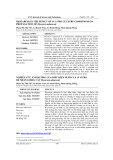



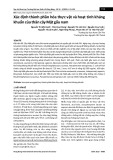
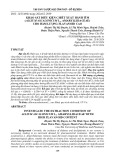


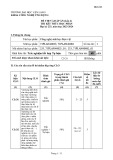
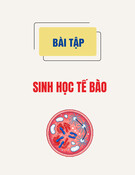

![Bài tập Đa dạng thế giới sống [kèm đáp án/ hướng dẫn giải]](https://cdn.tailieu.vn/images/document/thumbnail/2025/20251123/thaohoang9203@gmail.com/135x160/5861763951302.jpg)











![Câu hỏi trắc nghiệm Tế bào nhân sơ [mới nhất]](https://cdn.tailieu.vn/images/document/thumbnail/2025/20251104/xuangiao2601/135x160/40491762309854.jpg)
